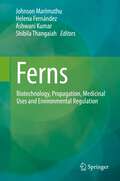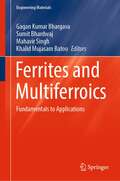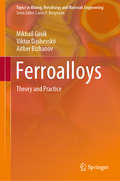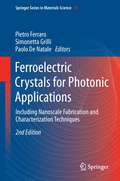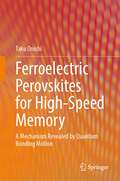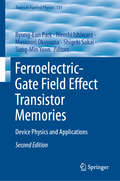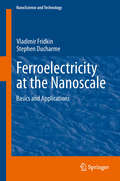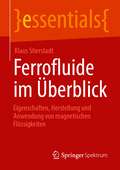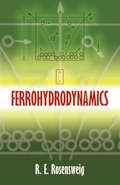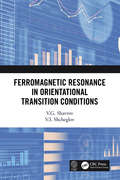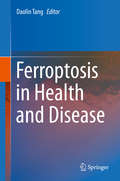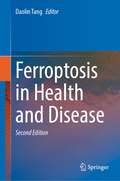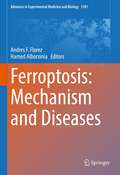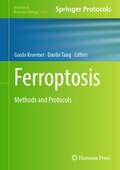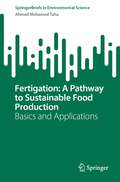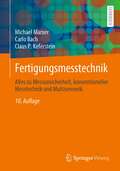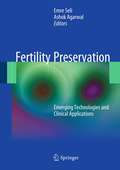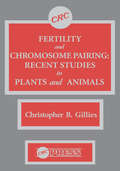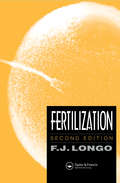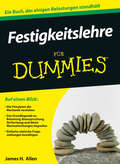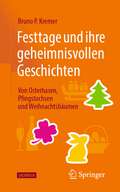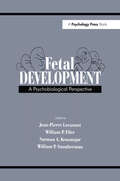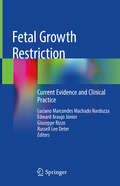- Table View
- List View
Ferns: Biotechnology, Propagation, Medicinal Uses and Environmental Regulation
by Helena Fernández Ashwani Kumar Johnson Marimuthu Shibila ThangaiahFerns are representative of genetic inheritance of great value as they include species of ancient vascular plants, which have direct connection with the evolution of plant life on Earth. This volume brings a selection of chapters covering a range of themes on fern biology, its development and growth, useful protocols for propagation and conservation purposes, genetic diversity, as well as medicinal and environmental applications.The content is organized into four parts: Biotechnology of Ferns Propagation of Ferns Ferns in Medicines Environmental Regulation This wide spectrum of the contributions provides quick access to information on the enormous potential of this plant group. This book brings together most recent research work and novel techniques, which is far from the traditional perspective usually followed. It is of interest to teachers, researchers, and botanists. Also the book serves as additional reading material for undergraduate and graduate students of agriculture, botany, forestry, and ecology.
Ferrites and Multiferroics: Fundamentals to Applications (Engineering Materials)
by Mahavir Singh Gagan Kumar Bhargava Sumit Bhardwaj Khalid Mujasam BatooThis book highlights the fundamentals of ferrites and multiferroic materials with special attention to their structure, types, and properties. It presents a comprehensive survey about ferrite and multiferroic materials, in areas significant to research and development in academia as well as in industry. The book discusses various types of methods applied for their synthesis and characterizations. This book is concerned with the fascinating class of materials with the promise for wide-ranging applications, including electromagnets, magnetic fluid hyperthermia, antenna applications, memory devices, switching circuits, bio-medical applications, actuators, magnetic field sensors and water purification, etc.
Ferroalloys: Theory and Practice (Topics in Mining, Metallurgy and Materials Engineering)
by Aitber Bizhanov Mikhail Gasik Viktor DashevskiiThis book outlines the physical and chemical foundations of high-temperature processes for producing silicon, manganese and chromium ferroalloys, alloys of molybdenum, vanadium, titanium, alkaline earth and rare earth metals, niobium, zirconium, aluminum, boron, nickel, cobalt, phosphorus, selenium and tellurium, iron-carbon alloys by carbon, silicone and aluminothermic methods. The chapters introduce the industrial production technologies of these groups of ferroalloys, the characteristics of charge materials, and the technological parameters of the melting processes. A description of ferroalloy furnaces is given in detail. Topics such as waste recycling, fines agglomeration technologies, and environmental issues are considered.
Ferroelectric Crystals for Photonic Applications
by Pietro Ferraro Simonetta Grilli Paolo De NataleThis book deals with the latest achievements in the field of ferroelectric domain engineering and characterization at micro- and nano-scale dimensions and periods. The book collects the results obtained in the last years by world scientific leaders in the field, thus providing a valid and unique overview of the state-of-the-art and also a view to future applications of those engineered and used materials in the field of photonics. The second edition covers the major aspects of ferroelectric domain engineering and combines basic research and latest updated applications such as challenging results by introducing either new as well as extended chapters on Photonics Crystals based on Lithium Niobate and Lithium Tantalate crystals; generation, visualization and controlling of THz radiation; latest achievements on Optical Parametric Oscillators for application in precise spectroscopy. Further more recent advancements in characterization by probe scanning microscopy and optical methods with device and technological orientation. A state-of-the-art report on periodically poled processes and their characterization methods are provided on different materials (LiNbO3, KTP) furnishing update research on ferroelectric crystal by extending materials research and applications.
Ferroelectric Devices: Research Misconceptions And Rectifications (Materials Engineering Ser.)
by Kenji UchinoUpdating its bestselling predecessor, Ferroelectric Devices, Second Edition assesses the last decade of developments—and setbacks—in the commercialization of ferroelectricity. Field pioneer and esteemed author Uchino provides insight into why this relatively nascent and interdisciplinary process has failed so far without a systematic accumulation of fundamental knowledge regarding materials and device development. Filling the informational void, this collection of information reviews state-of-the-art research and development trends reflecting nano and optical technologies, environmental regulation, and alternative energy sources. Like the first edition, which became a standard in the field, this volume provides a general introduction to ferroelectrics with theoretical background. It then addresses practical design and device manufacturing, including recently developed processes and applications. Updating old data with a forecast of future developments, the text analyzes improvements to original ferroelectric devices to aid the design process of new ones. The second edition includes new sections on: Pb-free piezoelectrics Size effect on ferroelectricity Electrocaloric devices Micro mass sensor Piezoelectric energy harvesting Light valves and scanners Multi-ferroic devices, including magneto-electric sensors Uchino provides a general introduction to the theoretical background of ferroelectric devices, practical materials, device designs, drive/control techniques, and typical applications. He presents frequently asked questions from students, lab demonstrations for practical understanding, and "check point" quizzes and model solutions to monitor understanding. After a thorough exploration of ferroelectric devices and their past, this book looks to the industry’s future, assessing market size and remaining reliability/lifetime issues. The author also unveils his strategy for developing "best-selling" ferroelectric devices.
Ferroelectric Perovskites for High-Speed Memory: A Mechanism Revealed by Quantum Bonding Motion
by Taku OnishiThis book is intended for theoretical and experimental researchers who are interested in ferroelectrics and advanced memory. After introducing readers to dielectric, perovskites, advanced memories, and ferroelectric, it explains quantum simulation. Then, using molecular orbital calculation results, it explains the ferroelectric mechanism in perovskite titanium oxides in concrete terms. Lastly, the book examines the materials designed for high-performance ferroelectrics and discusses the future of high-speed memory.
Ferroelectric Polymers: Chemistry: Physics, and Applications
by Hari Singh NalwaThis work covers the chemistry and physics of polymeric materials and their uses in the fields of electronics, photonics, and biomedical engineering. It discusses the relationship between polymeric supermolecular structures and ferroelectric, piezoelectric and pyroelectric properties.
Ferroelectric-Gate Field Effect Transistor Memories: Device Physics and Applications (Topics in Applied Physics #131)
by Byung-Eun Park Hiroshi Ishiwara Masanori Okuyama Shigeki Sakai Sung-Min YoonThis book provides comprehensive coverage of the materials characteristics, process technologies, and device operations for memory field-effect transistors employing inorganic or organic ferroelectric thin films. This transistor-type ferroelectric memory has interesting fundamental device physics and potentially large industrial impact. Among various applications of ferroelectric thin films, the development of nonvolatile ferroelectric random access memory (FeRAM) has been most actively progressed since the late 1980s and reached modest mass production for specific application since 1995. There are two types of memory cells in ferroelectric nonvolatile memories. One is the capacitor-type FeRAM and the other is the field-effect transistor (FET)-type FeRAM. Although the FET-type FeRAM claims the ultimate scalability and nondestructive readout characteristics, the capacitor-type FeRAMs have been the main interest for the major semiconductor memory companies, because the ferroelectric FET has fatal handicaps of cross-talk for random accessibility and short retention time. This book aims to provide the readers with development history, technical issues, fabrication methodologies, and promising applications of FET-type ferroelectric memory devices, presenting a comprehensive review of past, present, and future technologies. The topics discussed will lead to further advances in large-area electronics implemented on glass, plastic or paper substrates as well as in conventional Si electronics. The book is composed of chapters written by leading researchers in ferroelectric materials and related device technologies, including oxide and organic ferroelectric thin films.
Ferroelectricity at the Nanoscale
by Vladimir Fridkin Stephen DucharmeThe investigation of nanosized ferroelectric films and ferroelectric nanocrystals has attracted much attention during the past 15 - 20 years. There is interest in the fundamental and applied aspects. The theoretical basis is connected with the development of the Landau-Ginzburg-Devonshire (LGD) mean field and the first principles theories to the ultrathin ferroelectric films with thickness in the vicinity of critical size. Important potential applications are possible nanosize ferroelectric films in non-volatile memories, microelectronics, sensors, pyroelectric and electro-optic devices. This new area of research of ferroelectricity is still in impetuous development and far from completion. Many topics elucidated need generalization. The book contains theory and experimental data for a wide range of ferroelectric materials.
Ferrofluide im Überblick: Eigenschaften, Herstellung und Anwendung von magnetischen Flüssigkeiten (essentials)
by Klaus StierstadtDieses essential führt in das Gebiet der magnetischen Flüssigkeiten ein. In der Natur kommen sie nicht vor, aber in der Technik und in der Medizin dienen sie zu vielen nützlichen Zwecken. Diese Flüssigkeiten werden in aufwändigen Verfahren hergestellt und sind daher nicht billig zu haben. Ihre rheologischen Eigenschaften können mit relativ schwachen Magnetfeldern verändert und gesteuert werden. In der Technik dienen sie als Dichtungs- und Schmiermittel sowie für Pumpen, Kupplungen und Bremsen. In der Medizin werden sie zur Krebsbekämpfung und als bildgebende Kontrastmittel verwendet. Eine Substanz wie diese, die gleichzeitig flüssig und stark magnetisch ist, besitzt ein großes Anwendungspotenzial auf vielen verschiedenen Gebieten.
Ferrohydrodynamics (Dover Books on Physics)
by R. E. RosensweigThe behavior and dynamics of magnetic fluids receive a coherent, comprehensive treatment in this high-level study. One of the best classical introductions to the subject, the text covers most aspects of particle interaction, from magnetic repulsion to quasi-stable equilibriums and ferrohydrodynamic instabilities. Suitable for graduate students and researchers in physics, engineering, and applied mathematics.
Ferromagnetic Resonance in Orientational Transition Conditions
by V.G. Shavrov V.I. ShcheglovThe unique properties of ferromagnetic resonance (FMR) in magnetodielectric solids are widely used to create highly efficient analog information processing devices in the microwave range. Such devices include filters, delay lines, phase shifters, non-reciprocal and non-linear devices, and others. This book examines magnetic resonance and ferromagnetic resonance under a wide variety of conditions to study physical properties of magnetodielectric materials. The authors explore the properties in various mediums that significantly complicate magnetic resonance and provide a summary of related advances obtained during the last two decades. It also covers the emergence of new branches of the spectrum and anomalous dependencies on the magnetic field. Key Features: Reviews basic principles of the science of crystallographic symmetry and anisotropic solid-state properties Addresses the inhomogeneous nature of the distribution of the magnetization in the material being studied Explains the mathematic methods used in the calculation of anisotropic solids of a solid Provides the reader with a path to substitute electromagnetic waves when magnetostatic apparatus prove insufficient
Ferroptosis in Health and Disease
by Daolin TangThis book sheds new light on ferroptosis, as an only recently recognised form of regulated cell death. Its respective chapters address the numerous implications that ferroptosis can have for virtually all aspects of metabolism. They also share insights on the morphological characterisation of ferroptosis and highlight the different pathways of induction. Accordingly, the book offers a unique perspective on a mechanism that is involved in a multitude of pathologies, including cancer cell death, neurotoxicity, neurodegenerative diseases, acute renal failure, drug-induced hepatotoxicity, tissue ischemia/reperfusion injury, and T cell immunity. Readers will learn in which cell types this form of regulated cell death is likely to occur, and how it can be pharmacologically influenced, making the book a fascinating and informative read not only for scientists working in cell biology, but also for clinicians in the field of cancer research.
Ferroptosis in Health and Disease
by Daolin TangThis updated and expanded volume gives new insights on ferroptosis – an iron-dependent form of non-apoptotic cell death. The collection of chapters discusses the two major pathways through which ferroptosis can occur: the extrinsic or transporter-dependent pathway and the intrinsic or enzyme-regulated pathway.Readers will gain an understanding of the multiple levels, on which this special cell death is regulated. Hence, the contributions will take a closer look at epigenetic, transcriptional, posttranscriptional and posttranslational layers. Among the described regulators and transcription factors are GPX4, ACSL4 and NFE2L2. This edited volume collects reviews related to current knowledge on the integrated molecular machinery of ferroptosis, thereby also describing how dysregulated ferroptosis is involved in human diseases.
Ferroptosis: Mechanism and Diseases (Advances in Experimental Medicine and Biology #1301)
by Hamed Alborzinia Andrés F. FlorezThis book focuses on the emerging role of ferroptosis in human diseases. It gives a detailed perspective on how to induce or suppress ferroptosis to treat challenging conditions such as infectious diseases, including COVID-19, tuberculosis, parasitic diseases and cancer. The book serves as a practical guide by providing a valuable collection of all currently known activators or inhibitors of ferroptosis. It will enable readers to choose molecules for experimental design for in vitro and in vivo studies of ferroptosis. Furthermore, this volume highlights the aspects of iron metabolism and its connection to ferritinophagy, a ferritin selective autophagy, with profound implications in neurodegenerative diseases such as Alzheimer, Parkinson, Huntington and ALS. Lastly, it describes necroptosis, another important form of cell death, along with its connections to human disorders and potential crosstalk with ferroptosis. While covering basic concepts, the book delves into mechanisms and modulation of ferroptosis for treating a wide variety of human diseases thus offering a valuable and informative resource for both, scientists and clinical researchers.
Ferroptosis: Methods and Protocols (Methods in Molecular Biology #2712)
by Guido Kroemer Daolin TangThis volume provides a comprehensive collection of experimental protocols for investigating ferroptosis in different systems, including cultured cells, animal models, and human tissues. The techniques covered in this book look at various aspects of ferroptosis ranging from the detection of lipid peroxidation to the measurement of glutathione peroxidase activity and the evaluation of mitochondrial morphology. Chapters also discuss basic molecular biology methods such as quantitative PCR and immunoblotting, and advanced imaging techniques such as transmission electron microscopy and confocal fluorescence microscopy. Written in the highly successful Methods in Molecular Biology series format, chapters include introductions to their respective topics, lists of the necessary materials and reagents, step-by-step, readily reproducible laboratory protocols, and tips on troubleshooting and avoiding known pitfalls.Cutting-edge and authoritative, Ferroptosis: Methods and Protocols is a valuable resource for researchers who are interested in studying ferroptosis in different contexts including basic research, drug discovery, and clinical applications.
Fertigation: Basics and Applications (SpringerBriefs in Environmental Science)
by Ahmed Mohamed TahaThis book introduces basic and practical information on fertigation to researchers, extension agents and growers. To provide understanding of the basic issues regarding the appropriate selection of fertilizer injectors, fertilizer compounds used in fertigation for growing various field and horticultural crops. The book provides useful basic principles and practical information concerning fertilizer management and fertigation techniques of field, horticulture, and medicinal and aromatic crops. The book focuses on the agronomic value of fertigation practice and provides the reader with best practical advice required for successful fertigation based on the field experience. This book summarizes the basic principles and practices of fertigation techniques to ensure accurate and efficient crop nutrition. The book consists of 5 chapters covering the following topics: Introduction to chemigation and fertigation, selecting an injector for fertilizer/chemical injection, fertilizers for fertigation, major, secondary, and micronutrient fertilizers used in fertigation, and fertigation practices: Egyptian case study. It also includes appendixes for fertigation calculation examples, calibration of an injection pump, calculating the quantities of fertilizers needed for fertigation, nutrients requirements per each ton of crop yield produced, macronutrient requirements for some filed, fiber, fruit, vegetable crops, and medicinal and aromatic plants.Fertigation is one of the smart practices that help attains sustainable food production and minimize environmental pollution. Fertigation is the application of dissolved mineral fertilizers, soil amendments, and other water-soluble products to the roots of crops through irrigation water. This book provides understanding of the basic issues regarding the appropriate selection of injectors and fertilizer compounds used in fertigation for growing various field and horticultural crops which are essential to attain higher productivity, increasing food security and reducing food contaminations. It also clarifies the advantages of fertigation and set solutions to overcome its disadvantages.
Fertigungsmesstechnik: Alles zu Messunsicherheit, konventioneller Messtechnik und Multisensorik
by Claus P. Keferstein Michael Marxer Carlo BachDieses Lehrbuch stellt praxisnah taktile und optische Messverfahren zur Erfassung geometrischer Merkmale sowie der Sichtprüfung und Defekterkennung von den Handmessmitteln bis zur Mikromesstechnik dar, ebenso relevante Teile des Qualitätsmanagements. Neu wurden die Themengebiete Digitalisierung und Verfahren der künstlichen Intelligenz und des maschinellen Lernens in einem auf die Fertigungsmesstechnik zugeschnittenen eigenen Kapitel aufgenommen.Ein ausführliches Normenverzeichnis lässt schnell gültige Standards finden. Außerdem enthalten sind Links zu Metrologie-, Normen- und Akkreditierungsinstitutionen. Ein deutsch-englisches Sachwortverzeichnis ermöglicht ein schnelles Auffinden der gesuchten Begriffe sowie die Korrespondenz mit englischsprachigen Kollegen. Das Buch eignet sich besonders gut für eine praxisgerechte Ausbildung an Hochschulen und Weiterbildungsinstitutionen. Für jeden Fertigungsbetrieb, in Konstruktion und Entwicklung sowie im Messraum und Qualitätsmanagement ist dieses Buch ein zuverlässiges Nachschlagewerk und effizienter Ratgeber.
Fertility Preservation
by Ashok Agarwal Emre SeliA growing majority of women in the western hemisphere have been delaying initiation of childbearing to later in life. Consequently, more women in their late 30s to early 40s are attempting to get pregnant for the first time than ever before. Since the incidence of most cancers increases with age, delayed childbearing results in more female cancer survivors interested in fertility preservation. In this book, the editors provide strategies for fertility preservation in women and men who require gonadotoxic treatment. In addition, epidemiologic, ethical, medico-legal, psychologic, and social aspects of fertility preservation are discussed. Using a format that combines concise scientific background with practical methodological information and easy-to-grasp algorithms, the chapters all conform to a uniform structure, including a brief abstract, keyword glossary, step by step protocol of laboratory procedures, key issues in commentary and a list of references. The result is a unique, practical reference guide for reproductive endocrinologists, urologists, embryologists, reproductive scientists, and oncologists.
Fertility and Chromosome Pairing
by Christopher Bob GilliesThis book discusses the nature of meiotic chromosome pairing effects which may play a role in the determination of fertility. In particular, data and illustrations from the application of recently developed electron microscopic spreading techniques will allow researchers in related fields to come to grips with the recent advances in the cytogenetics of meiotic chromosome pairing behavior. Topics dealt with include meiotic and synaptonemal complex behavior in humans and mice with a variety of chromosomal and genetic abnormalities, sex chromosome pairing in mammals and birds, the significance for fertility or pairing in mammals and birds, the significance for fertility of XY pairing and crossing over, the effects of hybridity on pairing and fertility in plants, and the genetic control of synaptonemal complex formation and crossing over in polyploids. This is a timely reference book for graduate level medical and veterinary students, and scientists in the field of genetics and cell biology.
Fertilization
by Frank LongoThis edition provides the reader with an introduction to this subject. During the past five years there has been a virtual explosion of information on the different phases of fertilization.This book should be of interest to advanced undergraduates and graduate students in developmental biology, zoology and cell biology; researchers entering the field.
Festigkeitslehre für Dummies (Für Dummies)
by James H. Allen IIIWenn Sie wissen müssen, was ein Bauteil aushält und was nicht, kommen Sie an der Festigkeitslehre oder Elastostatik nicht vorbei. James H. Allen hilft Ihnen hier bei Ihren ersten Schritten. Sie erfahren das Grundlegende zu Belastung, Beanspruchung, Verformung und deren Wechselwirkungen. Außerdem führt der Autor Sie ein in die Besonderheiten einzelner Materialien wie Metalle, Polymere und Keramik. So müssen Sie weder den Mohrschen Spannungskreis noch das Hooksche Gesetz fürchten und können entspannter der Festigkeitslehre gegenübertreten.
Festtage und ihre geheimnisvollen Geschichten: Von Osterhasen, Pfingstochsen und Weihnachtsbäumen
by Bruno P. KremerMit diesem Buch werden Sie Feiertage wie Ostern, Pfingsten, Weihnachten und Silvester neu entdecken. Lernen Sie in der Chronologie des Jahreslaufs eine Vielzahl kultureller und meist auch überraschender sowie kurioser Hintergründe kennen und erfahren Sie, wie die jeweiligen Jahresfeste zu ihren besonderen organismischen Begleitern bzw. Symbolträgern kamen. Thematisiert und erläutert werden beispielsweise folgende Sachverhalte:Was hat Neujahr mit Hering und Weidenrinde zu tun?Warum sind Weihrauch und Myrrhe etwas Besonderes?Welche Palmen sind am Palmsonntag dabei?Ist der Osterhase eventuell ein Kaninchen?Pfingsten und die weiße Taube – ein Verständnisfehler?Johanniskraut und die „Pille“Ein paar Hintergründe zu Jack O’Lantern und HalloweenWas hat es mit den Barbarazweigen auf sich?Wieso hat Rudi das Rentier eine rote Nase?Von den Kamelen der Heiligen Drei Könige über den Pfingstochsen bis zum Schlittengespann des Weihnachtsmannes spannt sich somit ein thematisch weiter Bogen kreuz und quer durch unsere Kulturgeschichte. Die einzelnen Kapitel lesen sich amüsant und unterhaltsam.
Fetal Development: A Psychobiological Perspective
by Jean-Pierre Lecanuet William P. Fifer Norman A. Krasnegor William P. SmothermanBased on the presentations given by well-known specialists at a recent multidisciplinary conference of developmental psychobiologists, obstetricians, and physiologists, this book is the first exhaustive attempt to synthesize the present scientific knowledge on fetal behavior. Utilizing a psychobiological analytic approach, it provides the reader with an overview of the perspectives, hypotheses, and experimental results from a group of basic scientists and clinicians who conduct research to elucidate the role of fetal behavior in development. Experimental and clinical as well as human and animal data are explored via comparative developmental analysis. The ontogeny of fetal spontaneous activity -- via the maturation of "behavioral states" -- and of fetal responsiveness to sensory stimulation is studied in detail. Results are provided from studies of embryonic/fetal and newborn behavior in chicks, rats, sheep, primates, and humans. Knowledge of fetal behavior is crucial to the obstetrician, neonatologist, developmental psychologist, and even the future parents, in order to follow and assess the gradual development of spontaneous responsive movements of the fetus. While assessing this important information, this text also examines the neuro-behavioral events taking place during the fetal period as an aid to understanding normal and pathological life span development.
Fetal Growth Restriction: Current Evidence And Clinical Practice
by Giuseppe Rizzo Edward Araujo Júnior Russell Lee Deter Luciano Marcondes NardozzaFetal growth restriction (FGR) is a condition that affects 5%–10% of all pregnancies and is the second most common cause of perinatal mortality. Fetuses with FGR present with a greater risk of long-term health defects as impaired neurological and cognitive development and cardiovascular or endocrine diseases in adulthood. Due to its high prevalence and serious long term consequences, an in-depth understating of the diagnosis and management of FGR is essential for all those professionals involved in prenatal care, since it can prevent unwanted outcomes both to the mother and to the newborn. On the last years, the knowledge about fetal growth restriction has evolved considerably, with an increasing number of articles being published on this topic and new concepts being described, including new diagnostic guidelines. Even so, there are no recent books fully dedicated to FGR; this theme has only generally been discussed in chapters in larger obstetrics and neonatology books. This current book intends to present and discuss the state of the art on FGR in a clear and didactical way. It will focus on the main topics related to FGR, including its etiology, classification, prediction, diagnosis, and management, as well as on its neurological complications and maternal cardiovascular involvement. Written by experienced and renowned gynecologists from Brazil, Italy and the US, this book will be a comprehensive guide, directed to all gynecologists, radiologists and general practitioners who are involved in prenatal care, as well as to interns, residents, professors and researchers in the field.
